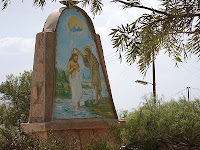 Get some PERSPECTIVE
Get some PERSPECTIVE
Massawa is one of two port cities in Eritrea bordering the Red Sea. Historically and culturally speaking Massawa has remnants of its ancient influence on the world as well as the world’s influence and ambition for it. Traveling the islands in between causeways, the remnants of the many ancient and present-past colonizers imposition on Massawa give the city a distinct disposition, a timeless city that has seen raiders of its desire and its devastation.
A Lesson in Histories
What is now Massawa in ancient times was known as the port city of Adulis. Adulis is one of the first known world ports and trade centers dating back as far as 3rd Century B.C. Trade occurred between Adulis, the Middle East, the Far East, Greco-Roman and the Western world. Adulis ushered in the emergence of the East African city-states as this port enabled the trading and commerce necessary to create the Axumite Kingdom and other inland city-states in present day Eritrea like Kohito, Keskese and Metera.
To understand the history of Massawa is really to understand the history of the entire Eritrean experience and its relation to the world. Below is a general timeline of what the city of Massawa has endured.
- 7th Century AD - The spreading of Islam in the Dahlak Islands, migration from the Arabian Peninsula and presence of the Persians in the Red Sea Area.
- 8th – 13th Century AD - The many Beja Kingdoms running from the Nile Valley to the Red Sea Coast
- 15th century - Midri Bahri (Land by the Sea) ruled by Bahri Negassi (Lord of the Sea) these were locally elected pockets of administration in and by what are now the Eritrean highlands. The capital of Bahri Negastat was Debarbwa.
- 1557 - The arrival of the Ottoman Turks and the Turkish Empire in Massawa and administration of the sea coast and ports
- Abyssinia’s desire for the highlands and overthrow of Bahri Negassi led to the alliance of the Portuguese (their desire was to overthrow the Turks and control Massawa)
- The Turkish Empire rules the lowlands for 300 years
- 1872 - The Egyptian Empire controls Massawa and parts of lowland Eritrea displaces the Turks
- 19th century - Abyssinian expansionism (Tigrean and Amhara) begins to take presence in various parts of Mere Milash (Eritrea)
- 1884 - treaty ends the Ethio-Egyptian scramble for Eritrea
- 1885 - Berlin Conference and Scramble for Africa during WWI leads to the Italian colonization of Eritrea and occupation of Massawa
- 1941 - British military administration of Eritrea, est. a military base in Massawa
- 1950 - By the auspices of the United States Eritrea is federated with Ethiopia (its political ally) by the United Nation General Assembly
- 1952 - US enjoys a naval base in Massawa
- 1962 – Ethiopia dissolves federation and announces Eritrea as part of the Ethiopian Empire
- 1961 – Armed struggle to free Eritrea begins by ELF (Eritrean Liberation Front)
- 1975 - Hirgigo Massacre by the Dergue military junta in Ethiopia during the Eritrean Liberation Struggle
- 1977 – Massive attack by sea, air and land by the Soviet Union and Ethiopia (Dergue regime) kills innocent civilians, destroys 90% of Massawa’s infrastructure
- February 1990 – EPLF (Eritrean Peoples Liberation Front) forces liberate Massawa through Operation Fenkil
The Island of Batse

On the island of Batse you will find two main attractions, the Ports of Massawa and Old Town all encircled by the Red Sea. Massawa was and still is a strategic geopolitical area. It is also the largest deep-water port on the Red Sea. The ports of Massawa and Assab (the other port city in Eritrea) are now developing into Free Trade Zones for small businesses all over the world.
Old Town includes shops, restaurants, cafes and bars. Its architecture is influenced by the Turkish and Egyptian presence on the coastlines. Some say the Egyptians used bricks while the Turkish used other decorative art like the photos below.



 While the structures are as old as the empires that left them, renovation has begun on the interior.
While the structures are as old as the empires that left them, renovation has begun on the interior.

Abdelkadir Kebire was one of the founding fathers of the "Eritrea for Eritreans" political party during the British administration of their country. A representative from Dahlak, he was a prominient speaker and political influence in Eritrean society. He was assassinated at the city center the day before he was to visit New York to address the UN General Assembly in regards to Eritrea and his parties stance for an independent Eritrea.
To this day people bring coffee and other gifts to remember him.
The Island of Tualud
The War Monument of Operation Fenkil – The three tanks facing the linking causeway as you enter Tualud is a statue of the exact place where the EPLF tanks halted in February 1990 when finally liberating Massawa. It also serves as the memorial site for the many civilians and martyrs that sacrificed their lives in Massawa.
PHOTO: National Holiday February 10: Operation Fenkil Anniversary
On this island you can find several inland hotels. Including the newly inaugurated Grand Dahlak Hotel. Previously Dahlak Hotel it was reconstructed. It has now become a primer attraction and destination stay.
PHOTO: Offices Twin Towers
PHOTO: Imperial Palace of HaileSelassie

















































 Photo: The side of the Polytech building on Warsai Avenue.
Photo: The side of the Polytech building on Warsai Avenue.